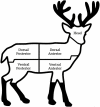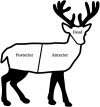Collecting Deer Keds (Diptera: Hippoboscidae: Lipoptena Nitzsch, 1818 and Neolipoptena Bequaert, 1942) and Ticks (Acari: Ixodidae) From Hunter-Harvested Deer and Other Cervids
- PMID: 33135746
- PMCID: PMC7604836
- DOI: 10.1093/jisesa/ieaa024
Collecting Deer Keds (Diptera: Hippoboscidae: Lipoptena Nitzsch, 1818 and Neolipoptena Bequaert, 1942) and Ticks (Acari: Ixodidae) From Hunter-Harvested Deer and Other Cervids
Abstract
Deer keds (Diptera: Hippoboscidae: Lipoptena Nitzsch, 1818 and Neolipoptena Bequaert, 1942) are blood-feeding ectoparasites that primarily attack cervids and occasionally bite humans, while ticks may be found on cervids, but are more generalized in host choice. Recent detection of pathogens such as Anaplasma and Borrelia in deer keds and historical infections of tick-borne diseases provides reason to investigate these ectoparasites as vectors. However, previous methods employed to sample deer keds and ticks vary, making it difficult to standardize and compare ectoparasite burdens on cervids. Therefore, we propose a standardized protocol to collect deer keds and ticks from hunter-harvested deer, which combines previous methods of sampling, including timing of collections, dividing sections of the deer, and materials used in the collection process. We tested a three-section and a five-section sampling scheme in 2018 and 2019, respectively, and found that dividing the deer body into five sections provided more specificity in identifying where deer keds and ticks may be found on deer. Data from 2018 suggested that deer keds and ticks were found on all three sections (head, anterior, posterior), while data from 2019 suggested that more Ixodes scapularis were found on the head and deer keds were found on all body sections (head, dorsal anterior, dorsal posterior, ventral anterior, and ventral posterior). The protocol provides an efficient way to sample deer for deer keds and ticks and allows researchers to compare ectoparasite burdens across geographical regions. Furthermore, this protocol can be used to collect other ectoparasites from deer or other cervids.
Keywords: deer; deer ked; hunter; sampling method; tick.
© The Author(s) 2020. Published by Oxford University Press on behalf of Entomological Society of America.
Figures





Similar articles
-
Patterns of deer ked (Diptera: Hippoboscidae) and tick (Ixodida: Ixodidae) infestation on white-tailed deer (Odocoileus virginianus) in the eastern United States.Parasit Vectors. 2022 Jan 20;15(1):31. doi: 10.1186/s13071-021-05148-9. Parasit Vectors. 2022. PMID: 35057829 Free PMC article.
-
A Technique for Dissecting the Salivary Glands From the Abdomens of Deer Keds (Diptera: Hippoboscidae: Lipoptena Nitzsch, 1818 and Neolipoptena Bequaert, 1942).J Insect Sci. 2020 Nov 1;20(6):4. doi: 10.1093/jisesa/ieaa027. J Insect Sci. 2020. PMID: 33135757 Free PMC article.
-
Limited detection of shared zoonotic pathogens in deer keds and blacklegged ticks co-parasitizing white-tailed deer in the eastern United States.Med Vet Entomol. 2023 Jun;37(2):179-188. doi: 10.1111/mve.12620. Epub 2022 Oct 26. Med Vet Entomol. 2023. PMID: 36286196
-
A brief review on deer keds of the genus Lipoptena (Diptera: Hippoboscidae).Vet Parasitol. 2023 Jan;313:109850. doi: 10.1016/j.vetpar.2022.109850. Epub 2022 Dec 2. Vet Parasitol. 2023. PMID: 36473321 Review.
-
Practical Guide to Trapping Peromyscus leucopus (Rodentia: Cricetidae) and Peromyscus maniculatus for Vector and Vector-Borne Pathogen Surveillance and Ecology.J Insect Sci. 2020 Nov 1;20(6):5. doi: 10.1093/jisesa/ieaa028. J Insect Sci. 2020. PMID: 33135755 Free PMC article. Review.
Cited by
-
Louse fly (Diptera, Hippoboscidae) associations with raptors in southern Canada, with new North American and European records.Int J Parasitol Parasites Wildl. 2021 Sep 23;16:168-174. doi: 10.1016/j.ijppaw.2021.09.007. eCollection 2021 Dec. Int J Parasitol Parasites Wildl. 2021. PMID: 34611511 Free PMC article.
-
Patterns of deer ked (Diptera: Hippoboscidae) and tick (Ixodida: Ixodidae) infestation on white-tailed deer (Odocoileus virginianus) in the eastern United States.Parasit Vectors. 2022 Jan 20;15(1):31. doi: 10.1186/s13071-021-05148-9. Parasit Vectors. 2022. PMID: 35057829 Free PMC article.
-
Detection of Anaplasma phagocytophilum DNA in Deer Keds: Massachusetts, USA.Insects. 2025 Jan 4;16(1):42. doi: 10.3390/insects16010042. Insects. 2025. PMID: 39859623 Free PMC article.
-
Special Collection: Protocols in Medical and Veterinary Entomology.J Insect Sci. 2020 Nov 1;20(6):1. doi: 10.1093/jisesa/ieaa122. J Insect Sci. 2020. PMID: 33135744 Free PMC article. No abstract available.
-
All for One Health and One Health for All: Considerations for Successful Citizen Science Projects Conducting Vector Surveillance from Animal Hosts.Insects. 2022 May 24;13(6):492. doi: 10.3390/insects13060492. Insects. 2022. PMID: 35735829 Free PMC article. Review.
References
-
- Apperson C S, Levine J F, and Nicholson W L. . 1990. Geographic occurrence of Ixodes scapularis and Amblyomma americanum (Acari: Ixodidae) infesting white-tailed deer in North Carolina. J. Wildl. Dis. 26: 550–553. - PubMed
-
- Baer-Lehman M L, Light T, Fuller N W, Barry-Landis K D, Kindlin C M, and Stewart R L Jr. 2012. Evidence for competition between Ixodes scapularis and Dermacentor albipictus feeding concurrently on white-tailed deer. Exp. Appl. Acarol 58: 301–314. - PubMed
-
- Beringer J, Hansen L P, Wilding W, Fischer J, and Sheriff S L. . 1996. Factors affecting capture myopathy in white-tailed deer. J. Wildl. Manage. 60: 373–380.
-
- Bloemer S R, Zimmerman R H, and Fairbanks K. . 1988. Abundance, attachment sites, and density estimators of lone star ticks (Acari: Ixodidae) infesting white-tailed deer. J. Med. Entomol. 25: 295–300. - PubMed
MeSH terms
LinkOut - more resources
Full Text Sources

